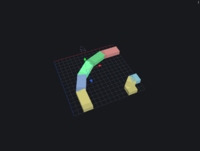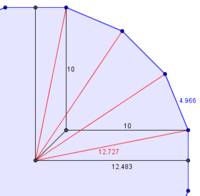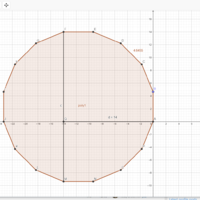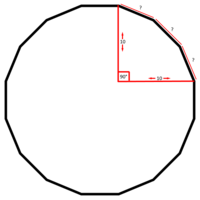Hexadecagon (16 side polygon) Help!
- Thread starter bikerbear
- Start date
D
Deleted member 4993
Guest
Is this a class-project? Do you know law of sines?View attachment 25031
So i need to know the length of the (?) sides! They all have to be the same length!
Been trying all day and havent been able to come up with an answer!
I've tried using a polygon calculator but since they calculate using the diameter of the whole thing i haven't gooten the answer im looking for.
Dr.Peterson
Elite Member
- Joined
- Nov 12, 2017
- Messages
- 16,814
First, it would be helpful to know the context of the problem: Is this for a class, or a contest, or what? What have you learned that might be useful?View attachment 25031
So i need to know the length of the (?) sides! They all have to be the same length!
Been trying all day and havent been able to come up with an answer!
I've tried using a polygon calculator but since they calculate using the diameter of the whole thing i haven't gooten the answer im looking for.
Second, one idea I have is to draw in the center, and segments from that to each end of the 10-unit segments. You can work out the angles in the resulting triangles, and from that find the triangle's side lengths; then there are several ways to find the lengths of the sides of the 16-gon.
Hi!
Thanks to all of you who took your time to reply!
This was not school related at all, in fact this is for a Videogame mod im developing where i needed to do a perfect 90° curve for a 3D model. And since the game engine only allows squares with a rotational threshhold of 22.5° i hade to use a hexadecagon to get the curve as round as possible with only 22.5° rotations.
Luckily i managedto figure this out by making a regular hexadecagon of the specified dimensions in an app called "GeoGebra" and then measured the sides.
The answer came out to be ≈ 4.6455/outer side if anyone is interested.
Here is a picture of the finished model!

Thanks to all of you who took your time to reply!
This was not school related at all, in fact this is for a Videogame mod im developing where i needed to do a perfect 90° curve for a 3D model. And since the game engine only allows squares with a rotational threshhold of 22.5° i hade to use a hexadecagon to get the curve as round as possible with only 22.5° rotations.
Luckily i managedto figure this out by making a regular hexadecagon of the specified dimensions in an app called "GeoGebra" and then measured the sides.
The answer came out to be ≈ 4.6455/outer side if anyone is interested.
Here is a picture of the finished model!

Dr.Peterson
Elite Member
- Joined
- Nov 12, 2017
- Messages
- 16,814
This was not school related at all, in fact this is for a Videogame mod im developing where i needed to do a perfect 90° curve for a 3D model. And since the game engine only allows squares with a rotational threshold of 22.5° i had to use a hexadecagon to get the curve as round as possible with only 22.5° rotations.
Luckily i managed to figure this out by making a regular hexadecagon of the specified dimensions in an app called "GeoGebra" and then measured the sides.
The answer came out to be ≈ 4.6455/outer side if anyone is interested.
Here is a picture of the finished model!
View attachment 25046
I just solved the problem with trig, and found that the side lengths are 4.966. Specifically, it was 2sin(11.25)sin(33.75)10sin(135). Then I constructed a hexadecagon with that side length in Geogebra to confirm:

I wonder if you used some different measurement.
Ah yes my bad! I ended up deciding to use different measurements. (14 instead of 10) and i also decided that the number (14) would be measured on another point of the polygon, As shown in picture below!I just solved the problem with trig, and found that the side lengths are 4.966. Specifically, it was 2sin(11.25)sin(33.75)10sin(135). Then I constructed a hexadecagon with that side length in Geogebra to confirm:
View attachment 25058
I wonder if you used some different measurement.


